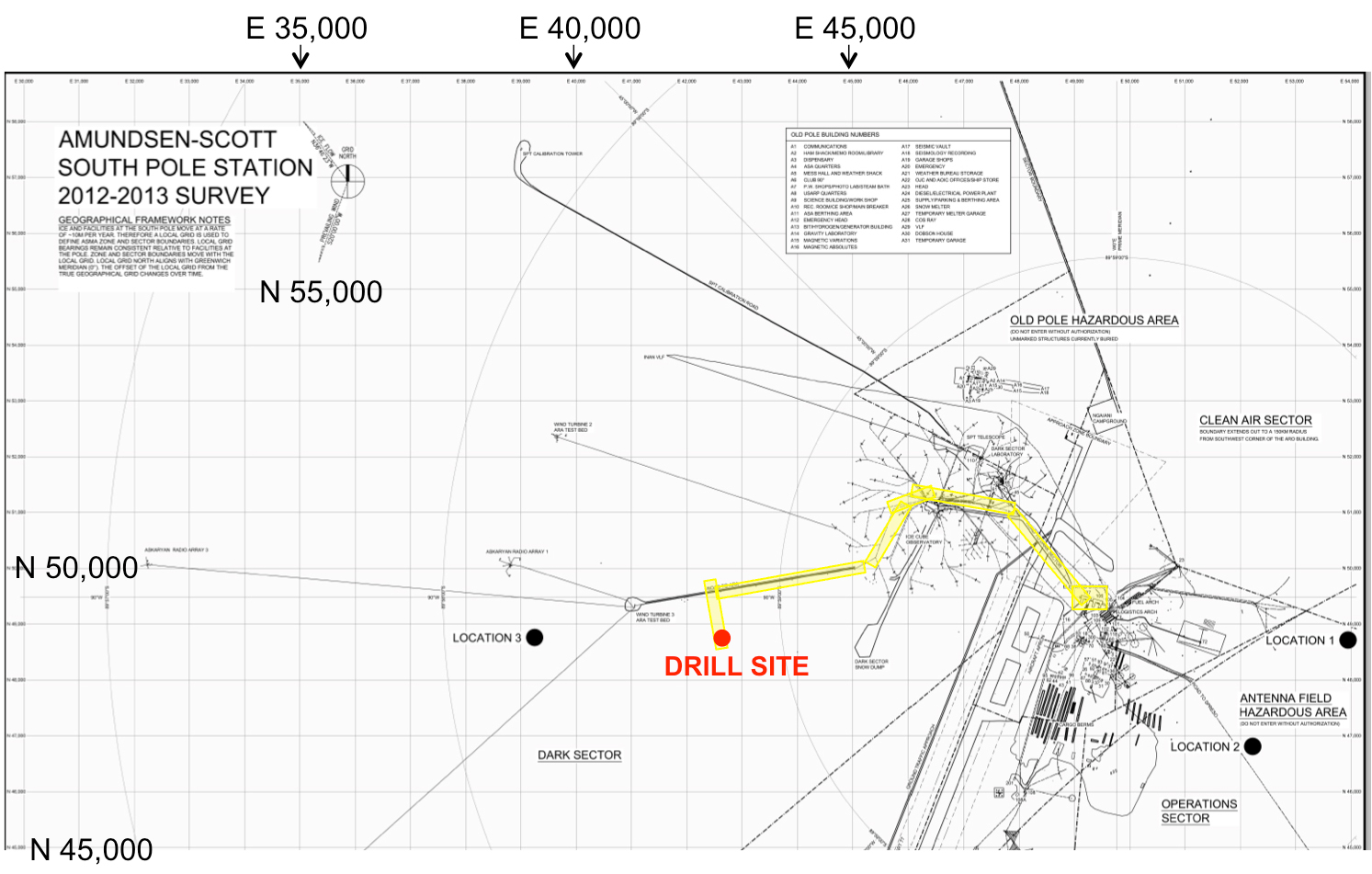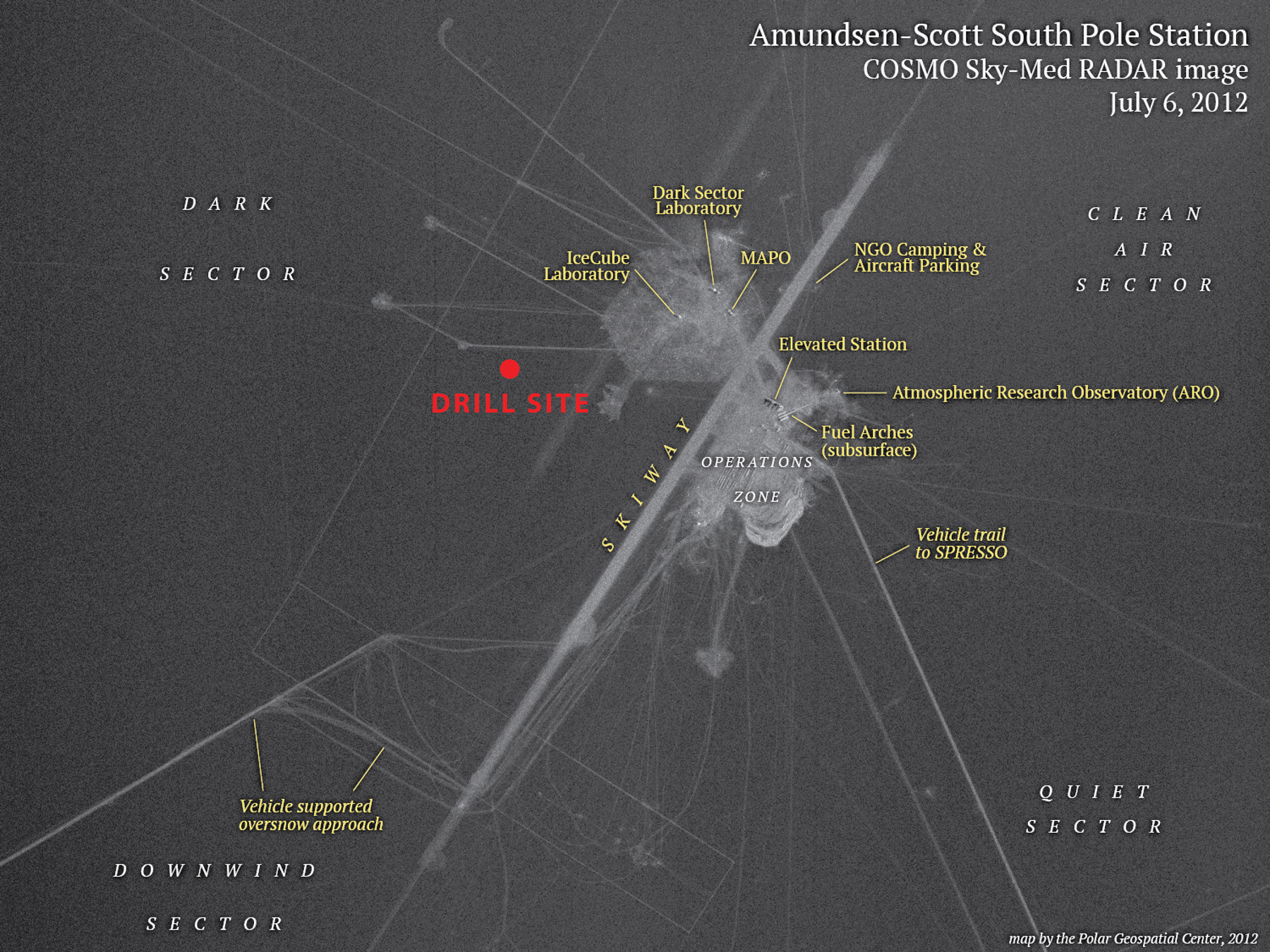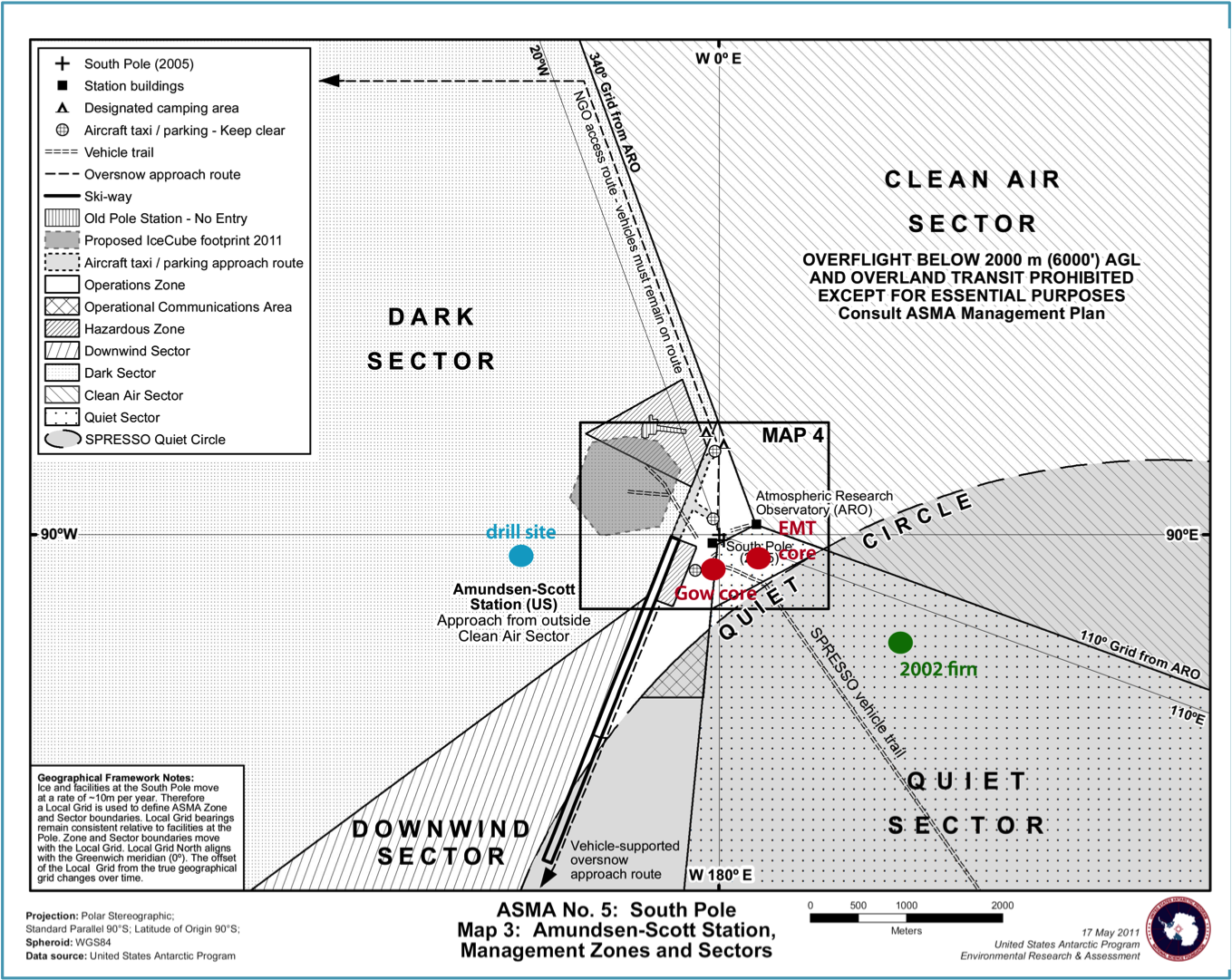About
Project Overview
The stable isotope, aerosol, and atmospheric gas records in ice cores provide exceptional archives of past climate. Supported by the U.S. National Science Foundation Office of Polar Programs, a new 1751-meter long ice core was recovered at the South Pole, extending more than 54,000 years into the past (Winski and others, 2019). The ice core was drilled during the 2014-2015 field season (0 to 736 meters) and 2015-2016 field season (736 to 1751 meters) using the new U.S. Intermediate Depth Drill. The South Pole site preserves unique climate records by combining cold temperatures typical of East Antarctica with a relatively high accumulation rate due to West Antarctic influence. The South Pole ice core extends the international array of ice cores used to investigate environmental change since the last glacial/interglacial transition. The scientific goal is to assess and understand changes in atmospheric chemistry, climate, and biogeochemistry.
Additional Reading
Getting to the Bottom of SPICECORE – Researchers drill deep into the ice beneath the South Pole to sample Earth's ancient atmosphere
The Antarctic Sun
April 12, 2016
Read story
Going deep – Drilling project to retrieve longest ice core ever from South Pole
The Antarctic Sun
March 26, 2015
Read story
Scientists drilling first deep ice core at the South Pole
University of Washington Press Release
January 20, 2015
Read story
SPICE-ing it up – New project plans to retrieve South Pole ice core beginning in 2014-15
The Antarctic Sun
March 8, 2013
Read story
Project Organization
With support from NSF's Office of Polar Programs, UC-Irvine (Aydin–Lead PI; NSF award #1142517), University Washington (Steig; NSF award #1141839), and the University of New Hampshire (Twickler and Souney; NSF award #1142646) – with assistance from NASA-GSFC (Neumann) – provided the overall scientific coordination for the project, which included site selection, field operations, core processing at the NSF Ice Core Facility, data management, and communications/workshops.
Logistical support was provided by NSF's Antarctic Infrastructure and Logistics program and was managed by Leah Street with the Antarctic Support Contract (ASC). Drilling support was provided by the U.S. Ice Drilling Program.
South Pole Field Operations
Below is a summary of the major field operations at South Pole.
| Field Season | Major Activities | Documents |
|---|---|---|
| 2013/14 |
|
|
| 2014/15 |
|
|
| 2015/16 |
|
|
| 2016/17 |
|
Funded Projects
The following is a summary of the universities/laboratories that received samples from the South Pole ice core. Over 10,300 samples have been cut to date from the ice core and distributed to sixteen individually-funded NSF investigators from thirteen U.S. institutions for analysis.
| State | University/Laboratory | Measurment | Investigator | NSF Award Number |
|---|---|---|---|---|
| CA | Univ. California, Irvine | Gases | Murat Aydin | 1443470, 1644245 |
| CA | Scripps Inst. Oceanography | Gases | Jeff Severinghaus | 1443710, 1543229 |
| CO | Univ. Colorado at Boulder | Water isotopes | Jim White | 1443328 |
| ME | Univ. Maine | Microparticles | Karl Kreutz | 1443397 |
| ME | Univ. Maine | Tephra | Andrei Kurbatov | 1543361 |
| NH | Dartmouth | Chemistry | Erich Osterberg | 1443336 |
| NM | New Mexico Inst. Mining and Technology | Tephra | Nelia Dunbar | 1543454 |
| NY | Columbia University/LDEO | Gases | Joerg Schaefer | 1443448 |
| NY | SUNY at Stony Brook | Gases | John Mak | 1443482 |
| NY | Univ. Rochester | Gases | Vasilli Petrenko | 1443267 |
| OR | Oregon State Univ. | Gases | Ed Brook | 1643722, 1443472, 1543267, 1443550 |
| PA | Pennsylvania State Univ. | Physical properties | Richard Alley | 1542778 |
| PA | Pennsylvania State Univ. | Gases | Todd Sowers | 1443464 |
| SD | South Dakota State Univ. | Chemistry | Jihong Cole-Dai | 1443663 |
| WA | Univ. Washington | Water isotopes, cosmogenic radionuclides | Eric Steig | 1443144, 1443105 |
| WA | Univ. Washington | Electrical conductivity | Ed Waddington | 1443232 |
Site Selection
During FFY 2013, Tom Neumann & Kimberly Casey (NASA-GSFC) and TJ Fudge & Eric Steig (University of Washington) led site selection activities using existing radar, accumulation, ice core, flow velocity, depth-age and surface elevation data. After reviewing the existing glaciological data, and after discussions with NSF and ASC regarding logistical considerations, a drill site for the South Pole ice core was established and approved by NSF in August 2013. The following paper in Annals of Glaciology talks about the site selection:
Casey KA, Fudge TJ, Neumann TA, Steig EJ, Cavitte MGP and Blankenship DD (2014) The 1500 m South Pole ice core: recovering a 40,000 year environmental record. Annals of Glaciology, 55(68), 137-146. https://doi.org/10.3189/2014AoG68A016



The drill site was located in the Dark Sector at roughly 89°59'S, 98°9'W approximately 200 meters perpendicular off the Road to ARA Wind Turbine 3 Test Bed (Figure 1a, 1b and 1c). The site was roughly 2.7 km travel distance from Elevated Station.
During the 2013-2014 field season, ASC conducted a 330 m x 330 m rectangular grid high-frequency ground penetrating radar (GPR) survey centered on 89.98S, 95.10W. The primary motivation for the GPR survey was to assess the potential for buried debris at or near the drilling site from the past ~50 years of station operations. Results indicate smooth and continuous layering, with no obvious disturbances in the upper 15 m on any of the profiles within the drilling area.